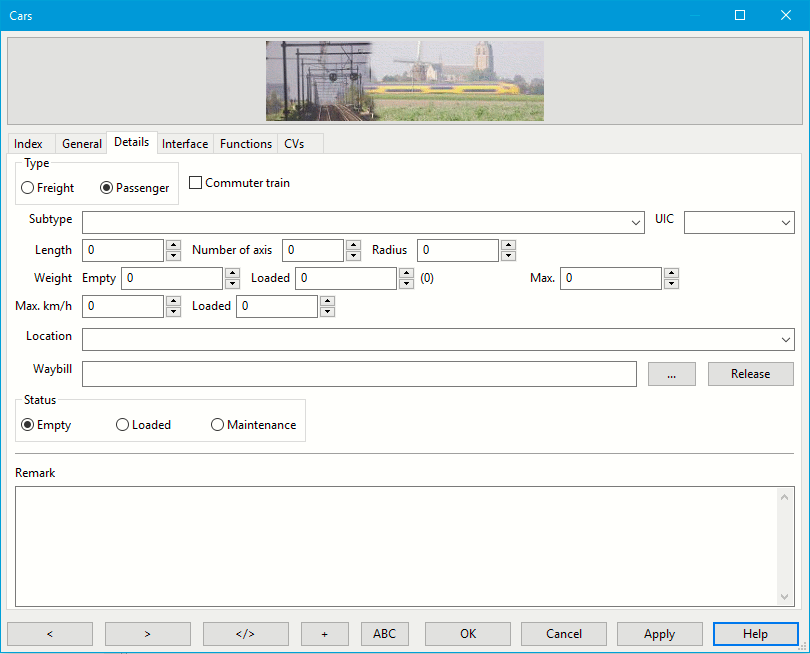Table of Contents
Car Details
Details
| All text fields which are marked with a @ can open the @Box by a single click on its label if the text field is not empty. The text field contents will be used to do a find. |
Type
Main type of the car: Freight or Passenger.
Commuter train
Used in context of trains; If the loco does not have the commuter flag set it checks the assigned train for a commuter flag.
Subtype
Specification of the main type.
Freight
- boxcar
- gondola
- flatcar
- reefer
- stockcar
- tankcar
- wellcar
- hopper
- caboose
- autorack
- autocarrier
- logdumpcar
- coilcar
Passenger
- coach
- lounge
- dome
- express
- dinner
- sleeper
- baggage
- postoffice
UIC
Official UIC classifications of Goods wagons and Railway coaches.
Length
 Scale length of the railroad car in the same units as used for block and loco lengths.
Scale length of the railroad car in the same units as used for block and loco lengths.
See Train for use of this parameter.
To avoid the addition of errors if many railroad cars are coupled, standardized reference points should be chosen for the determination of the individual car lengths. For example, recommends itself the center of the interlocking couplings, as for example the picture on the right for normal couplings of N scale. In principle, this may be applicable to all types of couplings and scales.
The unit, e.g. cm, mm or inch, is user-defined but has to be the same for all length definitions throughout Rocrail, i.e. Block Length and Automatic Settings. Depending on the scale used, the most suitable unit can be applied.
Radius
This number reflects the minimal radius of a wagon that can safely operate on curved tracks.
No checking is done, if this field is zero.
Wheel diameter
In combination with WIO, HALL and magnet, the real speed can be calculated.
Weight
Weight in tons.
The left number is the empty weight and the right one is the loaded weight. The value between brackets is the empty weight and the waybill weight added together.
See Adjust acceleration for use of this parameter.
The max. load is to prevent overload before a Waybill is assigned to this car. The default value is zero and is in this case not used.
Max. km/h
Used by the locomotive to which this train has been assigned in case set greater then zero.
The lowest of all train cars, greater then zero, will be used.
The "loaded" km/h value will be used, when the car status ís "loaded" (see Tab General)
See also: Train Max. km/h.
Location
The block in which the car actually resides.
The location will be updated automatically if the car can be identified by RFID, IR, RailCom or some other Bi-Directional technique.
Waybill
The waybill which is actually assigned to the car
If the waybill have a load weight entry, the weight of the load is added to the empty weight of the car by assigning and shown in brackets above
The Release button releases a assigned waybill
Status
- Unloaded - the "empty" settings of the car will be used
- Loaded - the "loaded" settings of the car will be used. State Loaded is set automatically by assigning a waybill.
- Maintenance
Remark
Free text to make some notes.


